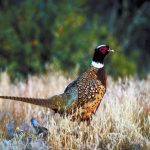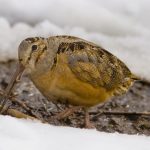Ruffed Grouse Forecast 2016: The Traveling Wingshooter
Ruffed grouse populations in the Lake States appear to be on the long-anticipated rise in their 10-year cycle. Minnesota’s ruffed grouse spring drumming counts were up 18 percent statewide this year, according to a survey conducted by the Minnesota DNR, and things appear promising in Michigan and Wisconsin. The 2016 populations won’t yet be spectacular, but the pinnacle of ruff hunting in the Northern forests is on the way.
Charlotte Roy, Minnesota DNR, reported that the weather has been favorable for good recruitment [the number of chicks that survive to adulthood] through June. The 2016 survey results revealed a statewide average of 1.3 drums per stop, up from 0.9, 1.1, and 1.1 in 2013 through 2015, respectively. The lack of an increase in 2015 in the cycle was likely attributed to a cold, wet spring that hurt production. For perspective, counts vary from about 0.6 drums per stop during years of low grouse abundance to about 2.0 during years of high abundance.
In Wisconsin, drumming counts were statistically flat statewide but up eight percent and four percent, in the Central and northern Regions, respectively.
“This statewide increase was small enough (+one percent) to not be statistically significant; but since our primary grouse range in the Central and Northern regions increased by a bit more, we’re hopeful that our population is headed back up toward the peak of the eight to ten-year cycle,” said Krista Pham, Wisconsin DNR.
Michigan DNR did not conduct a drumming survey this year but it is likely that grouse numbers closely track with that of Minnesota and Wisconsin.
According to Al Stewart, Michigan DNR, “Our trout fisherman and turkey hunters reported hearing more grouse drumming than in a long time. We expect this fall to be about the third year up from the bottom of the cycle. Ruff hunting was pretty good last year and it should be better this season.”
Michigan’s DNR has continued to expand its Grouse Enhanced Management Sites (GEMS) program and currently has 17 sites enrolled. Stewart recommends checking out the GEMS sites and then seeking similar habitat on the 10 million acres of public land open to grouse hunting in Michigan.
Ruffed grouse populations appear to be stable to slightly increasing in New England. Kelsey Sullivan, Maine Department of Inland Fisheries and Wildlife, said they have had favorable nesting conditions this spring/summer.
Drumming counts were down in portions of the north and central regions, but Sullivan attributes that a patchy population experienced last fall: “My overall take is that grouse numbers in the fall will be good but not bumper, and we may see the patchiness continue across the state.”
In New York, drumming surveys counts were slightly down from last year, but the warm and dry weather bode well for production, said Michael Schiavone New York State Department of Environmental Conservation. Andy Weik, Ruffed Grouse Society biologist for New England, reports that drumming survey data and anecdotal information from New Hampshire and Vermont, respectively, indicated this could be a good year to pursue ruffs.
In Pennsylvania, a mild winter, good mast crop, and a warm, dry spring all add up to a promising hunting season, says Lisa Williams, Pennsylvania Game Commission. Flush rates in 2015-16 showed a slight uptick from previous years, so populations may be on a slight rebound. Williams expects hunting to be fair-to-good overall and best in the western and central counties north of I-80.
To the contrary, Kentucky appears slated for a poor grouse season. Zak Danks, Kentucky Department of Fish and Wildlife Resources, reports that this spring’s grouse drumming survey revealed some of the lowest numbers on record.
New England Ruffs and the Wood Products Industry
It’s not every day that hunters and wildlife conservationists think of industry – in this case, an industry based on the cutting of trees – as vital to wildlife management. Albeit counter-intuitive, ruffed grouse populations across New England and other portions of the East closely follow trends of activity in the wood products industry, says Andy Weik of the Ruffed Grouse Society.Ruffed grouse require early successional forests and, at least in New England, that requires active forest management.
According to Weik: “Regions with an active timber industry and good markets for wood – such as northern New Hampshire, Maine, northern Vermont, and northern New York – tend to have the best grouse populations. Ruffs are disturbance-dependent birds that really need early successional forest habitats.”
Weik notes that a similar relationship between ruffed grouse and the wood products industry occurs in the twin tiers of northern Pennsylvania and northern New York with active forest management of the Allegheny hardwoods and black cherry forests.
Weik’s fresh message to grouse hunters: Think about what’s going on in the timber industry when planning your time chasing ruffs over bird dogs in New England.





